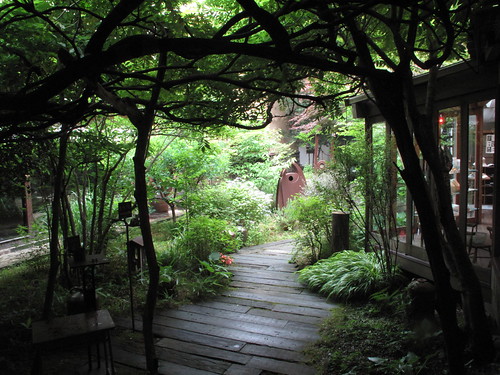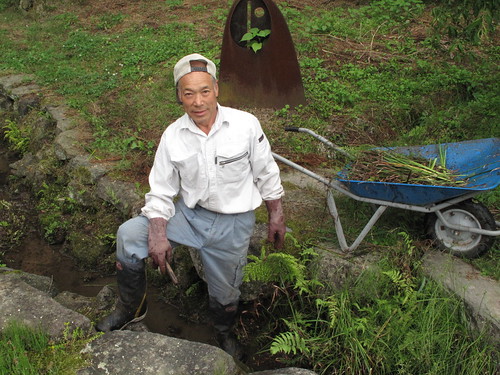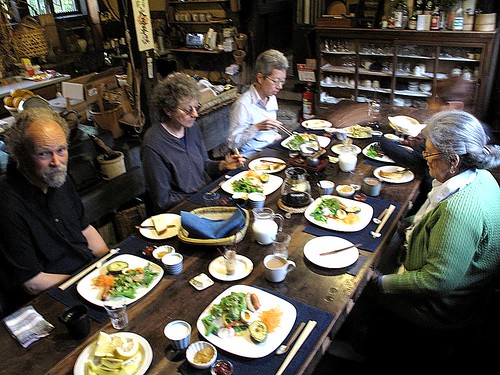There are a few places in the world that are truly enchanting. One such place is a town of just 500 people that has touched my life and the lives of many people I have taken there. It is a town near the Sea of Japan in Shimane Prefecture, in a long narrow valley, tucked between forested hills. Omori-cho has a sweetness that continues to call us back for, yet, another visit.
According to the person who most helped inspire the town’s restoration, Matsuba Tomi-san, “this used to be a place that no one ever visited.” She moved here thirty years ago with her husband Daikichi. A new mother at the time, she began to make baby clothes for her own children. Neighbors and friends liked what she did and requests for her work increased. Eventually, Daikichi began selling her work to retail stores, and the Gungendo Company was born. Over the past 30 years, the Matsubas and the growing Gungendo family have restored the eyesore of a town into a superb combination of esthetics and consciousness. Also, by supporting local farmers, mom & pop spinners, dyers and weavers, Gungendo has almost single-handedly saved them from bankruptcy due to the influx of cheap imports. With the resulting fabrics, they have created a line of adult clothing of extraordinary quality and distinctively Japanese design in addition to fine home accessories. (My favorite item is their shifu sheets, woven with cotton and spun washi paper.)
Rather than sell their products in well located boutiques in the hottest shopping districts of Tokyo and Kyoto, they have chosen to place their shops off the hyper-consumer path. They are not just selling clothes and household goods– they are selling a life-style that values natural materials, human relationships and revitalized rural aesthetics. Rather than restoring an old town into a random set of cold, museum-like buildings, they have brought an old town up-to-date. Gungendo and the Matsubas are to clothes and home accessories what Chez Panisse and the Slow Food Movement’s Alice Waters are to food.
The wooden, thatch and paper town is at once old and traditional and, at the same time, modern and comfortable. Old fashioned architectural elements have been revitalized and unobtrusively combined with modern conveniences.
Years ago, when Gungendo built their new company offices there, the shiny white prefabricated building looked out of place amongst the soft, mud, wood and bamboo walls and fences of its neighbors. So, they covered the new building with old barn siding and it immediately blended with the old minka farmhouse they had previously moved and restored next door. The thatched house became a place for company staff to eat lunch and take breaks. The concrete drainage ditch next door was lined with natural river stones and was transformed back into a “real” stream again.
The master construction person responsible for much of the restoration work in town is Kajitani-san. He has repaired and built waddle and daub walls, installed windows, paved walkways with old ceramic roof tiles or kiln bricks, put in electrical wiring and plumbing, unobtrusively and aesthetically created modern toilet rooms and baths in 250 year old houses. He is as comfortable working with bamboo as he is bringing old discarded barn doors and furniture back to life in a way that compliments living in the 21st century.
Nowadays, when Tomi-san is not reintroducing old Japanese textile patterns into next year’s clothing line at Gungedno, she can be found cooking a wonderful “slow food” meal on the 150-year old wood stove at Abeke House. With fish from the local seacoast and vegetables from kitchen gardens throughout the neighborhood, she has thoroughly delighted the palettes of all of the guests I have brought to Omori-cho over the years. One vegetarian herbalist from L.A. surprised his fellow travelers by deciding on-the-spot to eat a beef dish that Tomi-san prepared. He said, “I gladly make an exception to my vegetarian diet with food prepared with this much love.”
One of the main inspirations for the restoration of Omori-cho was American, Amy Katoh. For nearly 35 years, Amy has been promoting the simple beauty of Japan’s folk tradition, through her shop in Tokyo, the legendary Blue and White Shop, as well as through her four enormously popular books and speaking engagements. Her work has saved countless crafts and crafts people from disappearing. The Matsubas have received guidance and encouragement from Amy, who continues to support their efforts.
The restoration of 250-year old Abeke House was one of Tomi-san and Daikichi-san’s pet projects. It cost about $1,000,000 to transform an abandoned and completely dilapidated old house into an Architectural-Digest-Quality house that sleeps 12 people. It was a very long and very tedious project, but the result was a dream house fit for an enchanted town. A visit each year to Abeke House, Gungendo Company, the people, the food and the aesthetic of Omori-cho feels like coming home.







Comments
Wow Steve ! What a beautiful tribute to The Matsubas and their undying efforts to rescue the old Japan we all love! I am just finding this and am beyond honored to be included! Thank you!
STEVE BEIMEL INTRODUCED ME TO THIS PLACE AND I AM FOREVER GRATEFUL. WE SPENT ONE NIGHT THERE AND THE WHOLE EXPERIENCE WAS MEMORABLE. OVER TEN YEARS AGO AND IT IS AS IF IT WAS YESTERDAY. OMORICHO AND GUNGENDO. BRAVO STEVE!
Superb and well-thought-out content! If you need some information about Thai-Massage, then have a look at QH5